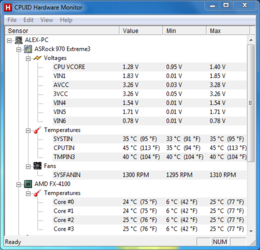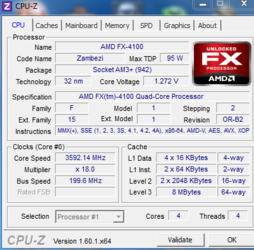- Joined
- Jul 6, 2012
Hi! I recently installed the Noctua Nh 14D on my Amd Fx-4100 and im am at stock clocks at the moment of 3.6 to 3.8Ghz and my temps on idle and web browsing are 33-37C and on full max out load in prime 95 it maxes at 45C. I want to overclock to at least 4.5 my goal is 4.7 but anyways I was wondering if these temps are right for normal stock clocks. I did notice this morning on the heat die on the cpu that some of the thermal paste had squished of and was just a little on the side of the die. What I'm saying is I don't know if I put to much, I put a grain of rice size but hey whatever, I also used the Noctua thermal paste included. So if anyone knows if these temps are good and I can begin overclocking then please tell me thank you everyone!
on my Amd Fx-4100 and im am at stock clocks at the moment of 3.6 to 3.8Ghz and my temps on idle and web browsing are 33-37C and on full max out load in prime 95 it maxes at 45C. I want to overclock to at least 4.5 my goal is 4.7 but anyways I was wondering if these temps are right for normal stock clocks. I did notice this morning on the heat die on the cpu that some of the thermal paste had squished of and was just a little on the side of the die. What I'm saying is I don't know if I put to much, I put a grain of rice size but hey whatever, I also used the Noctua thermal paste included. So if anyone knows if these temps are good and I can begin overclocking then please tell me thank you everyone! 



 on my Amd Fx-4100 and im am at stock clocks at the moment of 3.6 to 3.8Ghz and my temps on idle and web browsing are 33-37C and on full max out load in prime 95 it maxes at 45C. I want to overclock to at least 4.5 my goal is 4.7 but anyways I was wondering if these temps are right for normal stock clocks. I did notice this morning on the heat die on the cpu that some of the thermal paste had squished of and was just a little on the side of the die. What I'm saying is I don't know if I put to much, I put a grain of rice size but hey whatever, I also used the Noctua thermal paste included. So if anyone knows if these temps are good and I can begin overclocking then please tell me thank you everyone!
on my Amd Fx-4100 and im am at stock clocks at the moment of 3.6 to 3.8Ghz and my temps on idle and web browsing are 33-37C and on full max out load in prime 95 it maxes at 45C. I want to overclock to at least 4.5 my goal is 4.7 but anyways I was wondering if these temps are right for normal stock clocks. I did notice this morning on the heat die on the cpu that some of the thermal paste had squished of and was just a little on the side of the die. What I'm saying is I don't know if I put to much, I put a grain of rice size but hey whatever, I also used the Noctua thermal paste included. So if anyone knows if these temps are good and I can begin overclocking then please tell me thank you everyone! 





